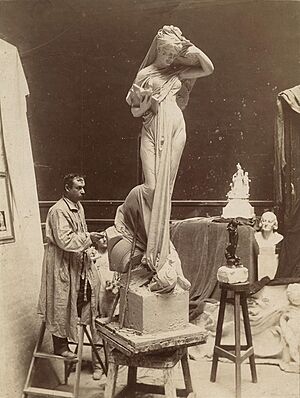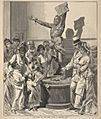Fernando Miranda y Casellas facts for kids
Fernando Miranda y Casellas (born 1842 – died May 9, 1925) was a talented Spanish-American artist. He was a sculptor who created statues and architectural designs, and he was also an illustrator who drew pictures for magazines.
Fernando was born in Valencia, Spain. His father was also an illustrator with the same name. Fernando studied art under a famous sculptor named José Piquer II. He moved to the United States before a big event called the 1876 Centennial Exposition, which was a world's fair. He settled in New York City. For several years, he worked as an illustrator for a Spanish-language magazine called La Ilustración Española y Americana. He also contributed drawings to Frank Leslie's Illustrated Newspaper, a popular American newspaper.
Contents
Big Ideas for Statues
Fernando Miranda had many grand ideas for large statues and fountains, especially in New York City.
Cervantes Monument
In 1878, he designed a huge 30-foot monument to honor the famous Spanish writer Miguel de Cervantes, who wrote Don Quixote. This monument was planned for Central Park in New York City. Sadly, the project never got enough money, so it was never built. However, a smaller part of his design, a Bust of Cervantes, was placed in Central Park. It stayed there for more than 25 years.
Columbus Fountain
Miranda also designed a very large fountain, 100 feet wide, to honor Christopher Columbus. This was also meant for Central Park, near 5th Avenue. But another sculptor, Gaetano Russo, already had plans for a Columbus Monument nearby at Columbus Circle. Because of this, Miranda's fountain project was also canceled. People suggested other places for the fountain, like Battery Park or Harlem, but it still didn't happen. Instead of Miranda's original work, Central Park decided to get a copy of a Columbus statue that was in Madrid, Spain. This copy was put up in 1894.
The Spirit of Research
In 1896, the Boston Public Library turned down a sculpture by another artist. Miranda then created a new sculpture to go in the library's courtyard fountain. His work was called The Spirit of Research. It showed a serious figure of a woman wearing a long gown, lifting a veil. This statue was meant to represent education and the idea of discovering new knowledge. It was placed in the fountain in 1898. However, it was removed by the 1920s. Later, in 1993, a copy of the original statue that the library had first rejected was put back in the fountain.
Achievements and Recognition
Fernando Miranda was a respected artist in his time. He was a member of the National Sculpture Society, which is an important group for sculptors. He also served as the very first president of the American Sculpture Society. In 1890, King Alfonso XIII of Spain recognized his talent and made him a Knight, which is a special honor.
Selected Artworks
Here are some of the notable works by Fernando Miranda:
- Bust of Ignacio Vergara Gimeno (1858): This was a student work. A copy of this bust is in Valencia, Spain.
- Bust of Miguel de Cervantes (around 1878): This bust was placed in Central Park, New York City.
- Bas-relief of Slumber and Head of Christ: These are other examples of his sculptures.
- Bust of Columbus (around 1892): This was part of his larger Columbus Fountain project.
- Four Terra-cotta Angels (1895–96): These are large, 20-foot tall angels made of terra-cotta (a type of clay). They decorate the top of the American Tract Society Building in New York City. They were restored in 2013-2014.
- The Spirit of Research (1897–98): This sculpture was made for the Boston Public Library.
- Fame (1903–04): This was a very large female figure created for the 1904 St. Louis World's Fair.
- City Hall Fountain (1906): This fountain is located in the City Hall Rotunda in Savannah, Georgia.
- The Primitive Marksman – Indian Shooting at a Soaring Eagle (1907): This sculpture is at the New York Historical Society in New York City.
Images for kids
See also
 In Spanish: Fernando Miranda y Casellas para niños
In Spanish: Fernando Miranda y Casellas para niños







